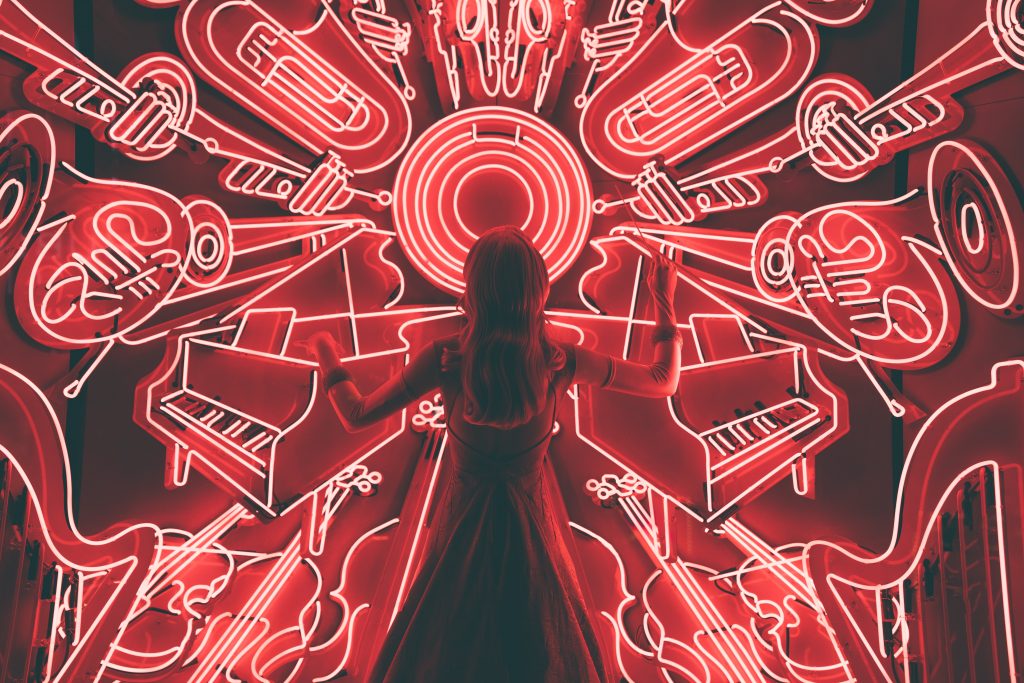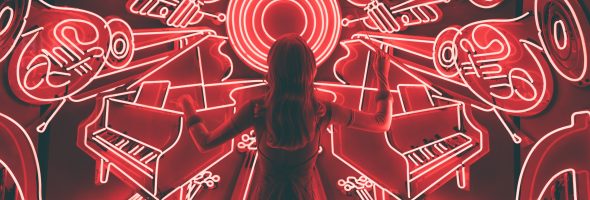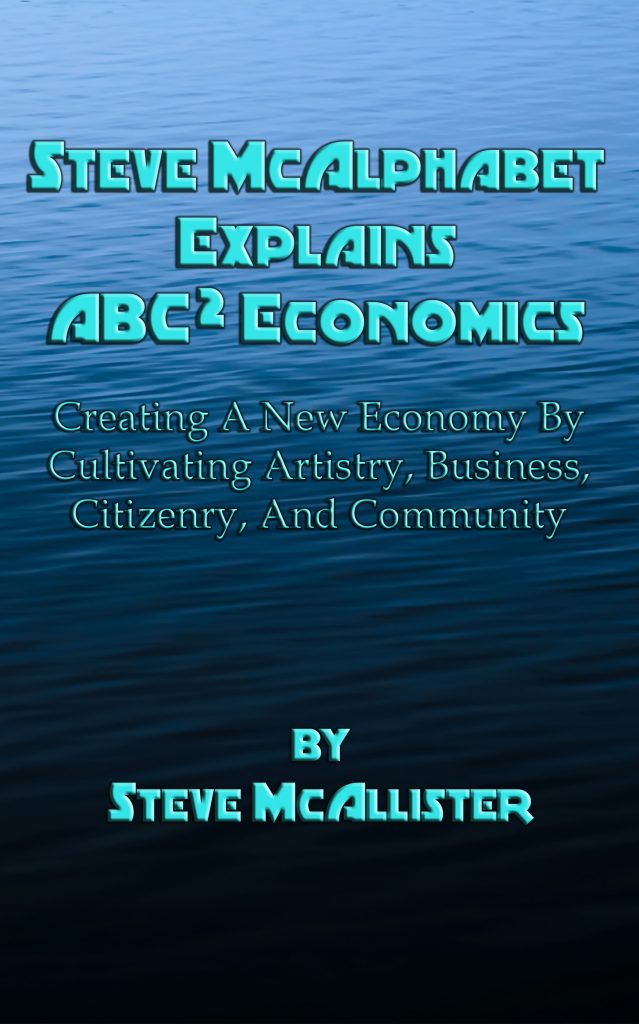Let’s look at how a song can be developed to be an economic instrument through ABC2 Economics.
Let’s say that I produce a song and release it as a downloadable mp3, a digital product that can be repeatedly downloaded as a residual source of income with no extra labor for me other than telling people about it. Imagine if I could preset all of the variables for how the revenue from this product should be channeled and activate it to automatically transfer those funds to all who are involved.
Just as with most products, digital or otherwise, there is a lot of collaboration involved in a song. As the writer, I have rights to the song, and in producing that song, I am able to share ownership of the recordings with the other participating artists. This allows us to all prosper more greatly from the distribution of the song, while also contributing to the society in which the song will be most greatly appreciated.
In taking the song from words on paper to a produced recording, I start by recording the guitar track, then the lead vocals. Then the drummer comes in to record a track, followed by a bassist, a mandolin player, and a background vocalist. Finally, the sound mixer cleans it all up to make it sound smooth, and we have a finished song.
Because talent is not easily quantifiable, we consider each artist’s investment in time. Evaluating the time that each Artist puts into a production allows us to properly allocate revenue to them when the production generates it.
Overall, not including the time to write the song, we’ve accumulated about a dozen hours of production time. The time that each artist has invested in the production of the song has been recorded, and we can log that into our Artist portfolio. Of course, now we need to consider the Business costs of getting the song to market. These include distribution, any advertising or marketing, touring and promotional costs, and whatever else it takes to get the song to the ears that want to hear it. So as the primary Artist, I make those connections with those who want to serve in those roles as affiliates.
In order to have a market in which people have enough stability and freedom to purchase musical and other artistic products, we need to have organizational structures that manage our collective resources and support an infrastructure that develops prosperity. This includes community organizations, schools, hospitals, city, county, state, and federal governments, and any other movements or institutions that contribute to a more engaged and effective Citizenry.
As the Artist of my life, I get to decide how much support I send to the organizations that contribute to supporting the world that allows me to make and share music. Basically, instead of the trickle-down income tax we’ve been serving for the last century, where the federal government absorbs the wealth and distributes it to states and municipalities, we instead empower people to invest more of their economic energy directly toward their local initiatives rather than have it hoarded and wasted by the beaurocracy of political theatre.
For instance, let’s say that this particular song was set to channel 20% to the Sarasota Bay Estuary Program, 20% to the City of Sarasota, 20% to Sarasota County, 20% to the State of Florida, 10% to the United States, and 10% to the United Nations. That, to me, seems like a much more efficient use of that money than the entirety of it being squandered by the federal government and its addiction to antiquated antagonism. As we cultivate our true Citizenry, we invest in ways in which we can all have greater mobility to pursue our interests while also being caretakers of the planet upon which we interact.
And lastly, we recognize that beyond the mess we make as we create the art of our lives, the world is a pretty messy and dangerous place. In order to make the most of it and decrease the suffering we naturally experience and the suffering that we fabricate and manufacture, we recognize ourselves as part of a greater Community and work to lift one another up. This is how we evolve as a species, at least, it always has been before.
Art should reach beyond being a mere material product for mindless consumption and strive to help alter and uplift our consciousness and make us a better people. So the artists involved in a song or other product can decide to channel some of the energy it creates toward endeavors that help to mend and heal what our civilizational activity has broken in the first place. As the lead Artist of a project, I collaborate with others, and we decide how much revenue from each product will go to fund charitable endeavors and social profit organizations, meaning that some products may channel a small percentage of revenue to a number of different recipients or they could be used as fund raisers for one particular endeavor.
Let’s say that these particular artists desire to use the song to help get water to the thirsty, food to the hungry, shelter to the homeless, and comfort for the sick and imprisoned. Let’s say that the Community portfolio is equally divided so that a portion goes to charity:water; a portion goes to the All Faiths Food Bank; a portion goes into a land trust that purchases properties to offer Housing First opportunities; a portion goes toward a universal healthcare system to ensure that everyone gets the care they need; and a portion goes toward a rehabilitation system to replace the punish-for-profit prison industry that is currently destroying lives all over the country.
Once the project is set up with an ABC2 Economics WeBMaP, each unit of currency it develops can be channelled toward these various portfolios to create the most efficient and effective means of financial distribution. For instance, let’s say one mp3 download generates a unit of currency (and while it theoretically could be a yen, euro, bitcoin or time dollar, for the sake of simplicity, let’s say it’s a dollar). So, from the dollar that is generated by the sale of the song, let’s say that seventy cents goes into the Artist portfolio, ten cents goes into the Business portfolio, ten cents goes into the Citizenry portfolio, and ten cents goes into the Community portfolio.
Of the seventy cents that goes into the Artist portfolio, half goes to the songwriter, and the rest is distributed to each of the contributing artists based on how much time each invested in the project. The ten cents that go into the Business portfolio are directed toward the affiliates who contribute toward bringing it to market and promoting it. The ten cents in the Citizenry portfolio are then channelled toward the city, county, state, and nation in which the song was produced, as well as any other endeavors that promote the greatest Citizenry. And the ten cents in the Community portfolio gets distributed to whichever social profit organizations or other charitable endeavors the Artists have selected.
While a single dollar may not seem like much of an economic generator, consider what it would generate if it sold a million copies. What if other artists were able to distribute their work in such a fashion, offering digital products, like photos, ringtones, podcasts, ebooks, NFTs, or even material products like framed prints, crafts, or pottery? What if filmmakers could use their collaborative prowess to tell stories and develop series that created residual streams of income for all of the artists involved, those who help promote it, the support of the world around them, and a positive change in the lives of others?
What if a million artists released their art into the digital marketplace with this sort of foundation, including the ability to change the percentages accordingly, and even to go deeper into each portfolio and engage more particularly with each endeavor? What if, instead of merely sending money to the federal government, citizens could decide how their money is spent and which initiatives it should support? What if, by realizing art as the instrument through which we can best manage money, humankind’s most abiding artform, we can harness the power of a truer sense of democracy and make the older technologies of representatives and lobbyists obsolete?
What if a billion life artists channeled the economic energy they produce in such a way?
Could this be the new mythology Joseph Campbell said we needed? What if we can use our art to change the world? That’s the question of ABC2 Economics.

This is an excerpt from the book Steve McAlphabet Explains ABC Squared Economics. Go to https://stevemc.xyz/books/steve-mcalphabet-explains-abc-squared-economics/ to find out more.


